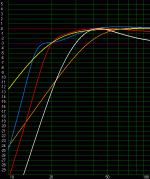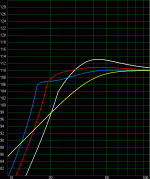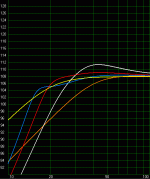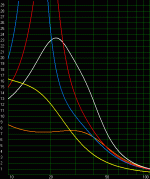Thanks again guys for your support!
Ok so the TS parameters of the Magnat are acording to the producer:
Qts= 0.58
Vas= 58 liters
Fs= 29 Hz
Xmax= 16 mm
Re= 3.2 ohms
Qms= 5.8
Qes= 0.65
Spl= 92 dB
Ok so the TS parameters of the Magnat are acording to the producer:
Qts= 0.58
Vas= 58 liters
Fs= 29 Hz
Xmax= 16 mm
Re= 3.2 ohms
Qms= 5.8
Qes= 0.65
Spl= 92 dB
This driver is very stubborn when it comes to designing a vented box! It has a very high Qts and it's much happier in a sealed box. In a vented box you get a nasty hump in the response, no matter what box size and tuning you pick. The only way to get rid of this is to use parametric eq. Try a 50L box tuned to 29 Hz with paremetric eq (fc = 45 Hz, Q=0.7, gain = -4db). It will look like the response of this driver in a 130L sealed box, except the cone excursion will be considerably less and you won't get near xmax with 300w. Not with music anyway.
If you have this thing in any kind of vented box you can be sure the response is ugly!
Probably best is to just put this thing in a sealed box with a linkwitz transform down to say 25 Hz. Put it in a 1 cubic ft or bigger box and give it a LT. With 100w you won't go past xmax until below 25 Hz. You will get about 105 dB @ 1m before room gain. With room gain you should be able to get flat to 20 Hz.
If you have this thing in any kind of vented box you can be sure the response is ugly!
Probably best is to just put this thing in a sealed box with a linkwitz transform down to say 25 Hz. Put it in a 1 cubic ft or bigger box and give it a LT. With 100w you won't go past xmax until below 25 Hz. You will get about 105 dB @ 1m before room gain. With room gain you should be able to get flat to 20 Hz.
So I need to make a sealed box of 28 liters or above and use a linkwitz transformer down to say 25 Hz...
Ooops a lot of work...
Can anyone help me with the LT schematic because I am a newbe...
And one more little question on top of all...
The RMS power of this driver is 220W how much power can I "put in" without damaging the speaker in this sealed box?
Because quality and durability are 2 of my main goals...
Ooops a lot of work...
Can anyone help me with the LT schematic because I am a newbe...
And one more little question on top of all...
The RMS power of this driver is 220W how much power can I "put in" without damaging the speaker in this sealed box?
Because quality and durability are 2 of my main goals...
Actually your box has an F3 of 35 Hz in that 70L box you have now. Block the vent (not with a sock) ... so you have a sealed box. You will have plenty of extension for music. A Linkwitz transform lets you get deeper bass in a smaller box.
You could probably use this sub with either a 250w or 350w amp. Neither will push it past excursion limits. If you got a 350w amp and played it continuously for a long period of time at its limits then you might cook the driver due to thermal limits. However, used judiciously it should be fine.
So I say make your box sealed and get an amp for this thing, preferably with 250w or more. If you want it smaller and would like a bit more depth, use a Linkwitz transform. You can find into at Elliott Sound Products website.
You could probably use this sub with either a 250w or 350w amp. Neither will push it past excursion limits. If you got a 350w amp and played it continuously for a long period of time at its limits then you might cook the driver due to thermal limits. However, used judiciously it should be fine.
So I say make your box sealed and get an amp for this thing, preferably with 250w or more. If you want it smaller and would like a bit more depth, use a Linkwitz transform. You can find into at Elliott Sound Products website.
Ok so I have a an amplifier that I build an has a maximum power of about 180-200 watts RMS (I went as high as 150w) on a 4 ohm load. I was thinking to try to use this amp and this subwoofer controler from Rod Elliott with it.
http://sound.westhost.com/project48.htm
The box I intend to use is the ugly one for the first listening test but if I can I will make it smaller.Is the amp enough?
Should I go for other LT design more complex?
http://sound.westhost.com/project48.htm
The box I intend to use is the ugly one for the first listening test but if I can I will make it smaller.Is the amp enough?
Should I go for other LT design more complex?
I would not use that sub controller. I would instead go with a Linkwitz transform. With that amp you would have spair excursion so you might as well eq the thing flat with an LT to 20 Hz. More power would be of benefit, even though the amp would have more power than the thermal rating of the driver. If you have that amp already then try it. Otherwise I suspect more power may be desirable. But don't go overboard as you don't want to cook it!
Thanks a lot Paul for being so patient with me and answering my questions.
And now 2 more: can I use some other design for this loudspeaker?
Would a sonotube sound a little better? I have no ideea how to simulate a sonotube.
And now 2 more: can I use some other design for this loudspeaker?
Would a sonotube sound a little better? I have no ideea how to simulate a sonotube.

A sonotube isnt nessicarily a different alignment, its just a different way to build the encosure. You calculate the air volume like you would do with a cylinder, you can port it or not, but since you didnt like the sound of your ported box, maybe it'd be better to go sealed.
How high you want to put a crossover on your subwoofer?
A 150 liters vented box tuned to 19.5 Hz give flat in-room (+0 -1 dB) response corner-loaded from 18 Hz to 51 Hz.
If you want to put a crossover higher than that, I don't recommend a vented enclosure...
Also, are you sure that you got the correct T/S parameters? The 92 dB/W/m rating doesn't work with the current T/S parameters.
A 150 liters vented box tuned to 19.5 Hz give flat in-room (+0 -1 dB) response corner-loaded from 18 Hz to 51 Hz.
If you want to put a crossover higher than that, I don't recommend a vented enclosure...
Also, are you sure that you got the correct T/S parameters? The 92 dB/W/m rating doesn't work with the current T/S parameters.
As BassAwdyO said (I keep thinking his name is Andy), the 92 db isn't right. WinISD pro calculates more like 85db based on the other parameters IIRC. This is more what I expect. Hence I hesitate to trust any of the parameters given. All the more reason to put this in a sealed box!
Sonotube is suitable to make a big sub that you don't need a forklift to move around. Their shape means the walls can be thin, and being tall they fit in corners and can be big without taking up too much floor space. In your case, there is not much point in using one. What you want is a small sealed cube. Say 350 x 350 x 350mm, solidly built with 18 or 25mm MDF, well braced.
A box should have as little of its own sound as possible. So the question is not "what does sonotube sound like" or "what does MDF sound like" but rather "how can I make the box as inert as possible?" Then it's a matter of finding the material and construction to do it.
Sonotube is suitable to make a big sub that you don't need a forklift to move around. Their shape means the walls can be thin, and being tall they fit in corners and can be big without taking up too much floor space. In your case, there is not much point in using one. What you want is a small sealed cube. Say 350 x 350 x 350mm, solidly built with 18 or 25mm MDF, well braced.
A box should have as little of its own sound as possible. So the question is not "what does sonotube sound like" or "what does MDF sound like" but rather "how can I make the box as inert as possible?" Then it's a matter of finding the material and construction to do it.
Yeah paul, I see that AwdyO looks a bit like andy at a glance, but I just made it up as my own way to spell audio. My real name is Mike, you can call me that if you'd like. BTW it was simon who said that the 92db wasnt right.
You could do a 6th order bandpass to extent that response to about 80 Hz or so...
If there is any doubt about the TS parameters, a bandpass is likely to be mis-aligned.
After modelling Simon's suggestion with the 150L box, I found some other alignments.
The chart shows your current box 72L tuned @ 29 Hz with an ugly looking response - shown in white. Orange - your current box sealed F3 @ 36 Hz - not bad but the Q is a bit high at 0.79. Use a LT for this box - yellow. You can now make the box smaller 28L, if desired and get the same response with a bit more eq - I haven't shown this as it will be essentially the same.
Now for some vented alignments. Red - 120L tuned @ 22 Hz gets F3 @ 20 Hz - almost identical to the Linkwitz transform. You could in fact make the box smaller with the same tuning and the result will be the response will roll off to to tuning point, which may in fact integrate with room gain better, depending on your room. 90L >>> -5 db @ 20 Hz which is similar to room gain in a lot of rooms.
Blue shows an EBS alignment for ultra deep bass - 140L with 18 Hz tuning. This may in fact get an inroom F3 as low as 15 Hz!
Attachments
Now for max SPL. What you have now will sound the loudest as it's tuned in the midbass. The sealed box has the least SPL as you can see. The 120L vented box actually looks the best of them all from an output point of view. Note: max SPL here is based on the alignment and driver excursion limits. Getting this output depends on the amp as well, and the driver being able to handle the power thermally.
Attachments
Now let's get a bit more real-world. Put in 200w and lets see what we get. Down to 40 Hz, there is barely an audible difference from a frequency response point of view. (excluding what you have now).
For music this is quite adequate. But what comes next will be telling (cone excursion) ...
For music this is quite adequate. But what comes next will be telling (cone excursion) ...
Attachments
The LT box now finds its limits about about 33 Hz. Below this you run out of excursion. This won't happen on much music however. Most will be above 40 Hz. Without the LT you won't run out of excursion with this much power (200w) at any point. The two vented boxes will run out of excursion below tuning, as expected. However this will only happen below 20 Hz, where you can use a rumble filter if desired. A 2nd order highpass at 15/16 Hz will prevent either from overexcursion.
So what's the conclusion?
For home theatre the big vented boxes are impressive. For music, however, there isn't much reason to choose a 150L vented box when you can get a 28L box with a barely a noticeable difference in output and extension.
One more chart - group delay. There is debate about whether this is audible. I believe that GD is most critical above 40 Hz, however excessive levels below this are probably not a good sign. If you take GD to be an indicator of "tightness" and control, then the LT version is clearly superior.
I've shown a LT with a Q of 0.707, but if you make it 0.5 for the 28L box you get a bit more rolloff which might match room gain a bit better. The GD is also even lower than the LT box shown (although in the less critical sub 40 Hz range) and the transient response might be slightly better, or at least in theory it should be. This would be my choice for music.
So what's the conclusion?
For home theatre the big vented boxes are impressive. For music, however, there isn't much reason to choose a 150L vented box when you can get a 28L box with a barely a noticeable difference in output and extension.
One more chart - group delay. There is debate about whether this is audible. I believe that GD is most critical above 40 Hz, however excessive levels below this are probably not a good sign. If you take GD to be an indicator of "tightness" and control, then the LT version is clearly superior.
I've shown a LT with a Q of 0.707, but if you make it 0.5 for the 28L box you get a bit more rolloff which might match room gain a bit better. The GD is also even lower than the LT box shown (although in the less critical sub 40 Hz range) and the transient response might be slightly better, or at least in theory it should be. This would be my choice for music.
Attachments
Thanks again for the detailed simulations.
I decided to try the sealed LT design. I can't begin working right now but in 3 weeks I'll start and I will tell what came out of this.
I decided to try the sealed LT design. I can't begin working right now but in 3 weeks I'll start and I will tell what came out of this.
Hello friends!
I have trouble in my appartment with low frequencies: my 2-way book-shelf speakers (45Hz @-3dB) works excellent in the small (12m2) room, but in the bigger room (~30m2) - low frequencies goes away 🙁
The simplest way is to use active correction, but it not accordign "my High-End feelings 🙂)
So, I've decided to transform 2-way speakers to 3-way speakers, adding Subs in the separate boxes, istead of the stands.
From some aspects, I've choose 46L boxes - 600mm height, 240mm width and 320mm depth (all measurements - internal !), but I'm very limited in the drivers.
For some reasons, I can choose only from 4 drivers:
8" Morel MW 265: Fs=30Hz, Vas=89L, Qts=0.44
8" Morel MW266: Fs=29 Hz, Vas=80L, Qts=0.56
10" Morel MW1075: Fs=29Hz, Vas=123L, Qts=0.62
12" Pioneer TWS-305C : Fs=32,7Hz, Vas=51,45L, Qts=0.34
(do not see the data in the Bass Box 6 database - It have a lot of errors !)
For my opinion - MW265 will be the best choise, but - what do You think ?
I have trouble in my appartment with low frequencies: my 2-way book-shelf speakers (45Hz @-3dB) works excellent in the small (12m2) room, but in the bigger room (~30m2) - low frequencies goes away 🙁
The simplest way is to use active correction, but it not accordign "my High-End feelings 🙂)
So, I've decided to transform 2-way speakers to 3-way speakers, adding Subs in the separate boxes, istead of the stands.
From some aspects, I've choose 46L boxes - 600mm height, 240mm width and 320mm depth (all measurements - internal !), but I'm very limited in the drivers.
For some reasons, I can choose only from 4 drivers:
8" Morel MW 265: Fs=30Hz, Vas=89L, Qts=0.44
8" Morel MW266: Fs=29 Hz, Vas=80L, Qts=0.56
10" Morel MW1075: Fs=29Hz, Vas=123L, Qts=0.62
12" Pioneer TWS-305C : Fs=32,7Hz, Vas=51,45L, Qts=0.34
(do not see the data in the Bass Box 6 database - It have a lot of errors !)
For my opinion - MW265 will be the best choise, but - what do You think ?
You should consider using a single sub. Instead of spending 2x the cost of a single 8 10 or 12, you can simply spend all the money on one driver that outperforms the others. Adire has the tempest and shiva which are pretty cheap, and could surely get you down another octave.
Altor, I'd suggest a new thread for this 😉
There are 2 ways you can go with this:
1. add a sub for more depth and output
2. biamped stereo woofers under your main speakers
You have described something more like #2, but you used the word "sub." I would make a box to match your mains and use a pair of 8" or 10" woofers like those you described, whichever can fit with the width of your mains without looking too chunky. Use an active crossover at 200 - 300 Hz and you will find improvements in the midrange and the overall dynamics of your system as well as more and deeper bass.
I think this is probably the way to go rather than a single sub, as he has commented that he is happy with them in a smaller room. This suggests he is just missing out on a bit of output and a bit of room lift he has probably lost. A sub can always be added afterwards.
There are 2 ways you can go with this:
1. add a sub for more depth and output
2. biamped stereo woofers under your main speakers
You have described something more like #2, but you used the word "sub." I would make a box to match your mains and use a pair of 8" or 10" woofers like those you described, whichever can fit with the width of your mains without looking too chunky. Use an active crossover at 200 - 300 Hz and you will find improvements in the midrange and the overall dynamics of your system as well as more and deeper bass.
I think this is probably the way to go rather than a single sub, as he has commented that he is happy with them in a smaller room. This suggests he is just missing out on a bit of output and a bit of room lift he has probably lost. A sub can always be added afterwards.
- Status
- Not open for further replies.
- Home
- Loudspeakers
- Subwoofers
- Looking for a Subwoofer Driver



